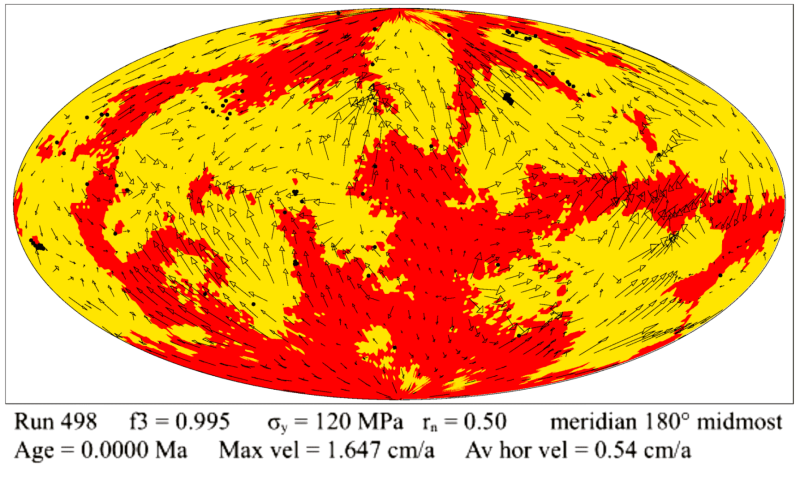Prof. Walzer Geodynamics and Geophysics
-
Curriculum Vitae
Curriculum Vitae
- since 1992 Professor of Geophysics at the Friedrich Schiller University of Jena, Germany
- Entry in the "Who'sWho in the World" since 2002, p. 2300, Marquis Who'sWho, USA
- 1999/2000: Los Alamos National Laboratory, NM, USA
- 1991: Dr. rer. nat. habil.
- 1982: Dr. sc. nat.
- 1969: Doctorate in geophysics (summa cum laude)
- 1968-1991: Research associate at the Jena branch of the Central Institute for Physics of the Earth
- 1964-1968: Scientific assistant at the Institute for Theoretical Physics and Geophysics in Freiberg, Germany
- 1959-1964: Studies of geophysics in Leipzig and Freiberg -
Memberships
Memberships
- German Geophysical Society
- European Geosciences Society
- European Association of Geochemistry
.
Image: Uwe WalzerComparison of our computed mantle-crust evolution model (panel a) with the observed global detrital zircon U-Pb age distribution and the low-frequency Model 2 of Puetz and Condie (2022). Time series for the 3900-0 Ma interval, binned at 10-Ma intervals. Panel b: Bandpass-filtered U-Pb age distribution from Combined-DB. Panel c: Low frequency model. Correlation coefficient = 0.788. This figure is from the paper U. Walzer, R. Hendel. Mantle evolution and continental growth eventspdf, 35 kb · de. Earth-Science Reviews, 104130, 2022.
.
Graphic: Uwe WalzerPresent-day distribution of the continents (red), oceanic lithosphere (yellow), and oceanic plateaus (black dots) for run 498. The quantities rn = 0.5, σy = 120 MPa, k = 5.0 W/(m·K), and f3 = 0.995 were kept constant. The arrows show the present-day creep velocities at the surface.This figure is from the paper U. Walzer, R. Hendel. Mantle evolution and continental growth eventspdf, 35 kb · de. Earth-Science Reviews, 104130, 2022.
.
Image: U. WalzerThe result of chemical evolution of the silicate spherical shell of the Earth, using the parameters σy = 110 MPa and rn = −0.5 (cf. Sect. 2), for the present day. We assume a modernized reservoir theory (cf. [4, 14, 23]). Strongly depleted portions of the mantle which include more than 50% depleted
MORB mantle are displayed by yellow areas. Enriched portions of the mantle with less than 50% depleted MORB mantle are orange-colored. In general, the yellow-orange boundary does not correspond to a discontinuity of the abundances of incompatible elements. The cross sections through the continents are red. This figure is from the paper U. Walzer and R. Hendel. Predictability of Rayleigh number and continental growth evolution in a dynamic model of the Earth's mantle.pdf, 2 mb In S. Wagner, M. Steinmetz, A. Bode, and M. Brehm, editors, High Perf. Comp. Sci. Engng. Garching/Munich 2007, pp. 585-600. Berlin, 2009.
Further results on the distribution and miscibility of geochemical reservoirs can be found in:
U. Walzer, R. Hendel. A geodynamic model of the evolution of Earth's chemical mantle reservoirspdf, 3 mb. In W. E. Nagel, D. B. Kröner, and M. M. Resch, editors, High Perf. Comp. Sci. Engng. '10 (HLRS), pp. 573-592. Berlin, 2011.
.
Image: U. WalzerA comparison of six equatorial sections showing the present-time state of the chemical evolution of incompatible elements of the Earth’s mantle. We use a modernized reservoir theory. Cf. Section 1. The depleted MORB mantle (DMM) and a mantle which is rich in incompatible elements, yet, are strongly intermixed. Strongly depleted parts of the mantle which include more than 50% DMM are represented by yellow areas. Relatively rich mantle parts with less than 50% DMM are orange-colored. In general, the yellow-orange boundary does not correspond to a discontinuity of the abundances of U,Th,K, etc. The
cross sections through the continents are red. Black dots represent the oceanic plateaus. The yield stress is 120 MPa, the viscosity-level parameter is -0.50.
This figure is from the paper: U. Walzer, R. Hendel. A Geodynamic Model of the Evolution of the Earth's Chemical Mantle Reservoirs.pdf, 3 mb In W. E. Nagel, D. B. Kröner, and M. M. Resch, editors, High Perf. Comp. Sci. Engng. '10 (HLRS), pages 573-592. Berlin, 2011.




